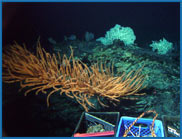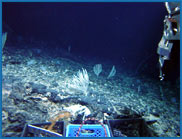Ecological and Evolutionary Relationships of Lost City Fauna
 |
The taxonomic and preliminary molecular genetic characterization of Lost City fauna are the critical first steps toward understanding the fundamental ecological and evolutionary relationships of fauna inhabiting this unique hydrothermal ecosystem and other species living at vents on the Mid-Atlantic Ridge. Species from Lost City fauna share similarities with known vent species. Mussels (empty shells) and shrimp have been observed and collected. On this cruise we will identify Lost City microhabitat conditions, including well-characterized chemistry, temperature, microbial communities, and mineral substrates from unoccupied vent microhabitats (i.e., where chemosynthetic animals would be expected to live). These will be compared with well-documented microhabitat conditions at vent sites along the Mid-Atlantic Ridge, which will provide insights into the key factors that may be functionally controlling habitat availability and larval dispersal.
 |
|
|
|
On this cruise, we will use traditional methods as well as molecular genetic approaches to identify taxonomic relationships (including expected new species) and evolutionary histories and assess biogeographic relationships. Detailed biological collections and imaging from Alvin imaging will be coupled with identification of habitat conditions, including vent fluid chemistry, temperature and microbial composition. We will also characterize the spatial distribution and microhabitat structure of the various species encountered in order to relate potentially novel ecological relationships to geological and geochemical conditions. The genetic relationships of discovered macrofaunal species (e.g., shrimp and mussels) will provide a first order understanding of the phylogeographic relationships of Lost City fauna with those known along the Mid-Atlantic Ridge and the evolutionary influence of hydrocarbon seeps and shallow Transform highs like the Lost City that may impede larval dispersal from vent sites along the Mid-Atlantic Ridge.
Our biological studies are aimed to:
• identify new species and determine if they occupy “traditional” or "novel" ecological niches;
• elucidate the evolutionary relationships among taxonomically-similar species inhabiting the Mid-Atlantic Ridge and hydrocarbon seep environments;
• provide a first order characterization of the composition and distribution of microhabitats within and outside the vent fields for future ecological studies.